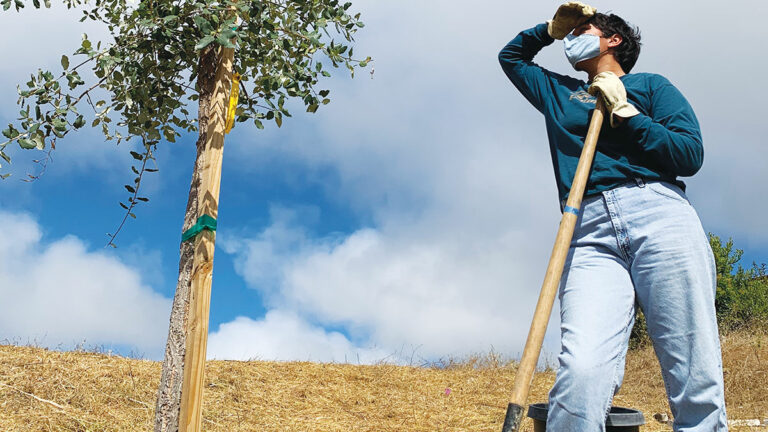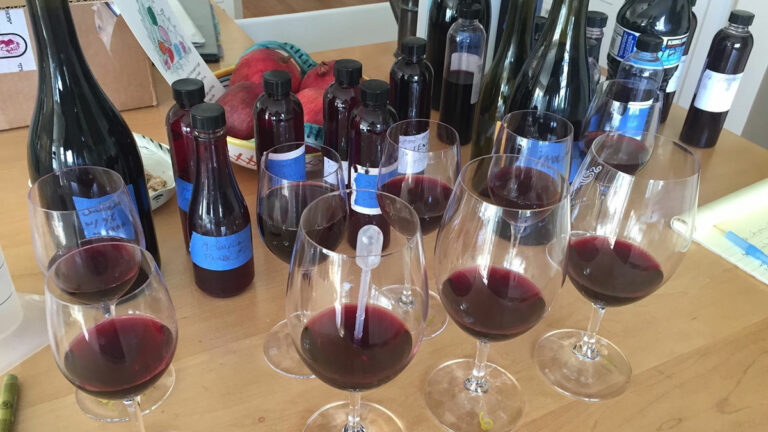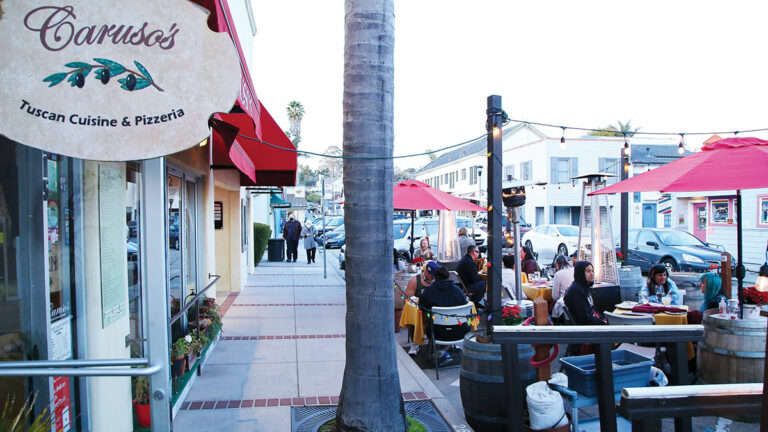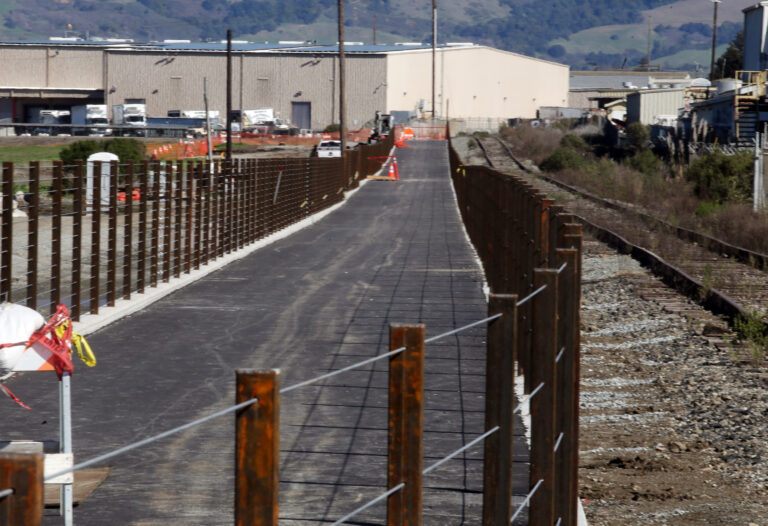“The narrative that you still hear is, ‘When this is over, and life gets back to normal … blah, blah, blah,’ And I’m trying to be like, ‘We can’t go back to normal. Normal was killing us all,” says Nancy Faulstich, executive director of Regeneración, a Watsonville-based climate justice organization. “The pandemic has shown some of the ways in which that was a totally unworkable system.”
Regeneración approaches climate change as a social justice as well as environmental problem. They spent the past year working on virtual and social media outreach, and discussing the intersections of climate change and equity in local spaces like city budgets.
“Climate resiliency is so intertwined with how the city is going to spend their money,” says Natalie Olivas, community organizer at Regeneración. “How are they protecting their people? How is our infrastructure going to hold up with all of these climate issues? Because the whole country has had such a difficult time responding to the pandemic, all of these issues are really being laid bare. And I think more people are starting to pay attention, and starting to see how it impacts their lives.”
Climate change is a global phenomenon that, to some, might seem like a distant threat. But Santa Cruz County has already started to feel the heat. Intensifying wildfires, droughts and heatwaves threaten lives and livelihoods across the county. Flooding and coastal erosion from rising sea levels are expected to worsen, jeopardizing everything from city infrastructure to surf spots.
Santa Cruz County, of course, is home to many climate-focused organizations; some have worked in the community for years, while others only recently formed. Their individual focuses vary, but all of the groups have had to adapt to the age of Covid-19. And despite the significant challenges, many of them say the past year has taught them new organizational strategies and helped them focus their missions.
“We’ve seen throughout history that during moments of crisis and upheaval, it’s an opportune time for societies to pick up the ideas that are lying around and make rapid transformations and advancements,” says David Shaw, coordinator of the Right Livelihood College at UCSC and a Ph.D. student in environmental issues.
Shaw also works as the director of Santa Cruz Permaculture. He is heartened by the number of new gardens around Santa Cruz and the way people have altered their behavior during the past year.
“One of the things that the pandemic has shown us is that change is not only necessary, it’s possible,” he says. “We’ve been able to make tremendous changes locally and globally, because we’ve had to. And so now, anyone who says we can’t make big changes is just flat out wrong.”
He isn’t the only activist who feels this way.
“Overall, I’m encouraged to see how flexible people are, how adaptable they are, how they can make changes,” says Pauline Seales, an organizer at the Santa Cruz Climate Action Network. She feels especially encouraged by the number of people now riding bikes and the changing role of the work commute.
“Tons of people are working from home and will not go back to nine-to-five commuting Monday through Friday,” she says.
But the pandemic set back other advancements. The use of disposable products like takeout containers increased, plastic bag bans lifted and zero-waste campaigns screeched to a halt.
Still, climate activists have stayed determined. “We’ve found ways to get everything that we were doing done,” says Lynda Marín, chapter lead for the Citizens’ Climate Lobby Santa Cruz chapter. “And it may be that we will hold onto some of these things even after Covid.”
Save Yourselves
Santa Cruz has a rich history of environmental and climate activism, and many of its local groups worked together for years before the pandemic. Those relationships might have saved some of them.
“I think that we’ve benefited during this time from having a pretty strong connective tissue,” says Marín. Citizens’ Climate Lobby has hosted joint online discussions with the Santa Cruz Climate Action Network, for example. “We have a lot of good overlap and communication, and trust and friendship,” she says.
That communication spans generations. Youth for Climate Justice, a Santa Cruz youth-led organization inspired by the global Fridays for Future movement, planned climate strikes before the pandemic with groups like the Climate Action Network.
Since the shutdowns, they haven’t organized strikes. But the groups got creative, hanging signs and banners around town to show solidarity with past climate strikes.

Many of the activists say watching the younger generation gives them the most hope. But young climate activism leaders emphasize that progress cannot just be up to them.
“It has to be everybody,” says Tamarah Minami, a ninth-grade student at Santa Cruz High School and one of the founding members of Youth for Climate Justice. “We have a limited amount of time before we’re not going to be able to stop climate change anymore. And just because we’re in a global pandemic doesn’t mean that that time is paused.”
Since the start of the pandemic, Youth for Climate Justice has turned its attention from large strikes to local projects. Efforts include getting free bus passes for students, trying to stop the construction of a new parking garage downtown and calculating carbon emissions at schools.
“I think we’re going to continue working on local projects,” says Minami. “I think it’s important that we shifted to start working on those.”
Most of their projects take place online, along with weekly meetings. The group has kept their momentum, but not without challenges. “It’s hard to keep students engaged,” says Minami. “Especially after we already are sitting on Zoom for five hours every day.”
But one advantage to the virtual format, she says, is connecting with students who don’t live nearby.
These connections and the ability to reach more diverse networks in a time of isolation form an ironic motif among several of the climate groups.
“It’s been really fantastic to be able to work with a wider range of volunteers than we would have if we were doing everything in person,” says Olivas from Regeneración.
“We’ll have to think about what kinds of events we want to keep doing online versus in person,” says Faulstich. “It just hugely expands the potential audience, the accessibility to it, and the speakers.” A recent virtual forum hosted by Regeneración and CSUMB garnered over 1,000 views on Facebook.

Moving Forward
Still, higher online engagement cannot replace motivated members. Without an active core group, things might start to fall apart.
Such is the case for the Santa Cruz hub of Sunrise Movement, a national youth-led climate justice organization. “We need leaders,” says Cori Strell, a former hub coordinator for Sunrise. Organizations don’t always need more passive members, she explains.
When weekly meetings turned virtual, the group’s attendance dwindled. Several of the college students who formed the membership moved away, and leadership fell to someone outside of Santa Cruz.
The shrinking group tried phone banking for climate-minded political candidates. But the virtual burnout proved too strong for many of the members.
“I really like climate justice when I get to work with people,” says Strell. “It’s been really hard to justify unpaid labor without the positive outcome.” She and a few of the remaining members recently discussed merging with a Bay Area hub in an effort to salvage the group.
Many of the activists plan to continue holding certain events virtually, engaging communities on social media and widening their reach. But unsurprisingly, most of them are also eager to return to in-person action.
One area in particular where groups face challenges during the pandemic is working with local governments.
“I think that government agencies are a bit more insulated from public accountability, since their meetings are being held online and they take public comment one at a time,” says co-chair of the Campaign for Sustainable Transportation Rick Longinotti. “There’s something about a room full of people that I think has some influence.”
Seales from the Climate Action Network feels similarly. “By theory, you can access city council meetings via Zoom,” she says. “It’s an incredibly difficult interface.”
She, too, misses the atmosphere of a room full of passionate people. “In normal times, if there was any hot issue, a bunch of people would show up with signs,” she says. “There was an overall mood of ‘for’ or ‘against,’ which is completely lost with this.”
But despite the city council complications, the Santa Cruz Climate Action Network managed to stay involved in city projects. “We’ve played a fairly big role in the city’s Climate Action Plan,” says Seales.

The group paid particular attention to making sure equity is included in the plan. Improving equity and addressing the social issues that underlie climate change looked different for many groups this year, but several of them rose to the challenge.
“This past year has been an incredibly focusing process for us as an organization to really hone in on what we feel are the most critical and important parts of our work,” says Jonathan Pilch, executive director of Watsonville Wetlands Watch. “We’ve had to take a lot of different steps to ensure that community engagement is really still at the heart of our work, but how that looks is very different.”
Watsonville Wetlands Watch used to host environmental education programs for 4,000 youth in the Pajaro Valley every year. At the start of the pandemic, they focused on making videos and broadcasting to as large an audience as possible.
But the group soon decided to focus their efforts on a few teachers and students individually through virtual or hybrid in-person programs. One of these programs is a small, paid job training program called the Climate Core Leadership Institute (CCLI).
CCLI students go through four weeks of socially distanced training, then plant trees, maintain trails and restore native habitat around the Pajaro Valley. Watsonville Wetlands Watch plans to continue the program post-pandemic.
“We’ve seen a tremendous amount of value in developing an effective small cohort of teens who are working on the issue of climate change through the Climate Core Leadership Institute,” says Pilch. “And so we want to make sure that level of engagement is sustained and deepened even more so while we also expand our broader community engagement.”
As vaccines roll out, schools and businesses reopen and life begins to feel more normal, relief might feel like a long-lost emotion resurfacing. We’re a long way from feeling similar relief about the climate crisis. But local activists encourage people to stay engaged, stay connected to their communities and stay hopeful.
There will be loss, but there can also be success. “I really think we can do this,” says Faulstich from Regeneración. “We can do what’s needed to protect life on Earth.”

























